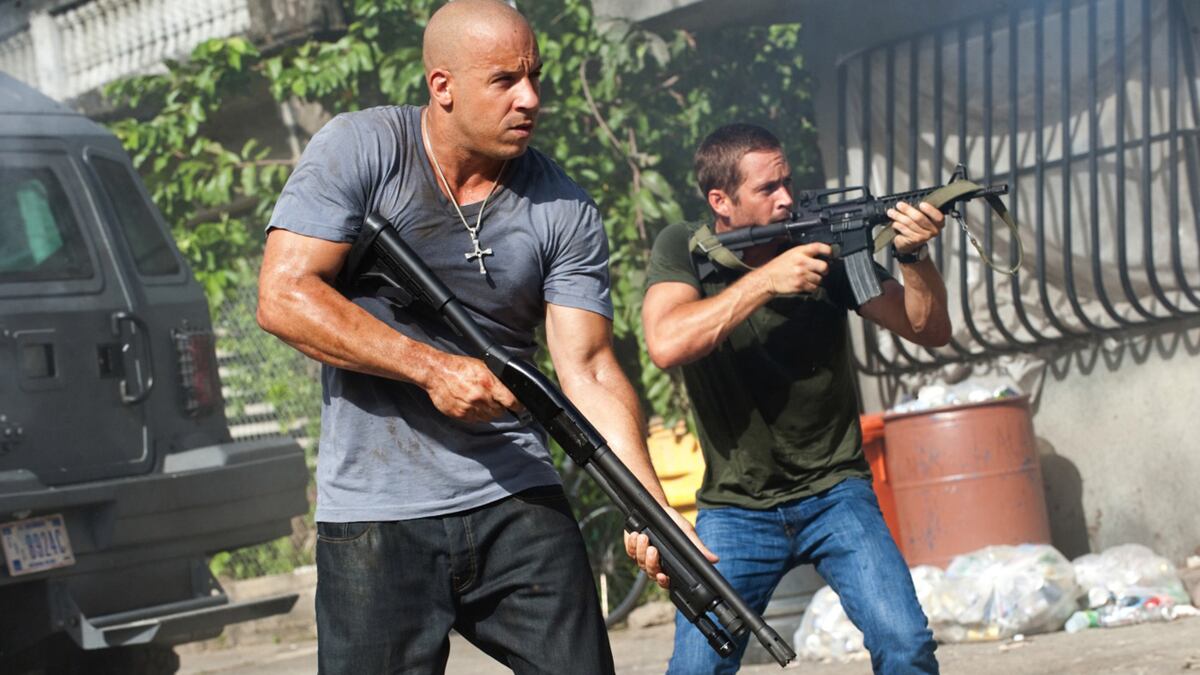There is a scene in Fast Five—the 2011 blockbuster that transformed the scrappy Fast & Furious franchise into an epic of vehicular warfare—where street racer Dominic “Dom” Toretto (Vin Diesel) sums up the soul of the series for his crew.
“Money’ll come and go, we know that,” Dom declares. “Most important thing in life will always be the people in this room—right here, right now. Salute, mi familia.”
Dom’s proclamation is somewhat absurd, given that the Fast & Furious films are often about stealing money (from a Tokyo crime lord, a Rio crime lord, or anyone else with a wallet or a safe) and always make money ($5.9 billion in worldwide box office so far).
That doesn’t mean you should dismiss Dom’s devotion. For 20 years, the series has made heavy-metal poetry out of cars, airplanes and anything else that can go boom. Yet the reason we’re still watching is because it’s an adventure both kickass and heartfelt—and because the story of how it got that way is mesmerizingly bizarre. So in anticipation of the June release of F9, the next chapter in the saga, now is the time to recount that history and rewatch those films for free at select area theaters.
It all began in 2001 with The Fast and the Furious, an entertainingly junky crime flick about Los Angeles police officer Brian O’Conner (Paul Walker) betraying his badge to join Dom and his cronies. It holds up, but not as well as 2006′s Tokyo Drift, the first Fast & Furious film directed by Justin Lin, the daredevil auteur whose style would define the series.
In the early to mid-aughts, Lin was best known for Better Luck Tomorrow, a garish teen odyssey that gleefully tried to demolish the “model minority” stereotype used to degrade Asian Americans. With Tokyo Drift, he tried to demolish Hollywood’s obsession with overly frenetic action, unleashing car chases edited and choreographed for maximum clarity.
Tokyo Drift peaks during a chase down a mountain highway filled with harrowing moments that you feel in your body. When a 1967 Mustang nearly goes off the road, we see a blissfully terrifying shot of a wheel hovering over the edge—an image that sealed Lin’s ascendance into the rarefied realm of directors who turn action into art.
While Tokyo Drift starred a cast of newbies (including Sung Kang as Han, a character he played in Better Luck Tomorrow), Diesel and Walker returned for 2009′s Fast & Furious. That film is as bland as its amusingly uncreative title, but it set up the superior Fast Five, in which Dom journeys to Rio for a $100 million heist.
After four films, Lin was succeeded by director James Wan (Saw), who helmed the series during its defining trauma: the death of Walker, who perished in a real-life car crash. Furious 7 ends with Diesel as Dom eulogizing his co-star: “No matter where you are, whether it’s a quarter mile away or halfway across the world, you’ll always be with me.”
By Furious 7, we had seen characters fall in love, become parents, switch careers, live and die. The series was reckoning with time—and Walker’s passing forced that reckoning out of the subtext and into the spotlight, where it confronted mortality with unexpected grace.
Crass commercialism occasionally overshadows the franchise’s nobler pursuits. Mad Max has socialism and feminism; Fast & Furious has Corona product placement and the male gaze (the films are addicted to greedily gazing at women from behind). Authentic unwholesomeness may be better than phony Hollywood virtue, but that doesn’t make it defensible.
Yet the Fast & Furious films have always seemed immune to criticism—maybe because they speak to moviegoers in ways that not all film series do. While The Avengers stars a team of mostly white elites, Dom is the patriarch of a diverse working-class clan. He’s more Captain America than Steve Rogers.
No film embodies the contradictory nature of Fast & Furious better than Fast Five, which returns to theaters on Friday as part of a series of free screenings leading up to the new sequel F9, which Lin returned to direct. Fast Five has the glorious spectacle of Dom and Brian racing through a favela on foot, but it also has a tender scene where Brian worries that he will emulate his emotionally distant father.
“You ain’t gonna be like that, Brian,” Dom reassures him. A lot of actors would throw that line away and say, “It’s just a Fast & Furious movie.” Diesel gives it the emotional weight it deserves, daring us to laugh at his unabashed sincerity. When an actor does that, there’s nothing left to say except, “Salute.”
SEE IT: Both AMC Theatres and Regal Cinemas are offering free screening of films in the Fast & Furious franchise every Friday. Visit amctheatres.com/fastfridays and regmovies.com/static/en/us/promotions/fast-friday for details on how to obtain tickets. The remaining schedule includes Fast Five on May 28, Fast & Furious 6 on June 6, Furious 7 on June 11, and The Fate of the Furious on June 18.
